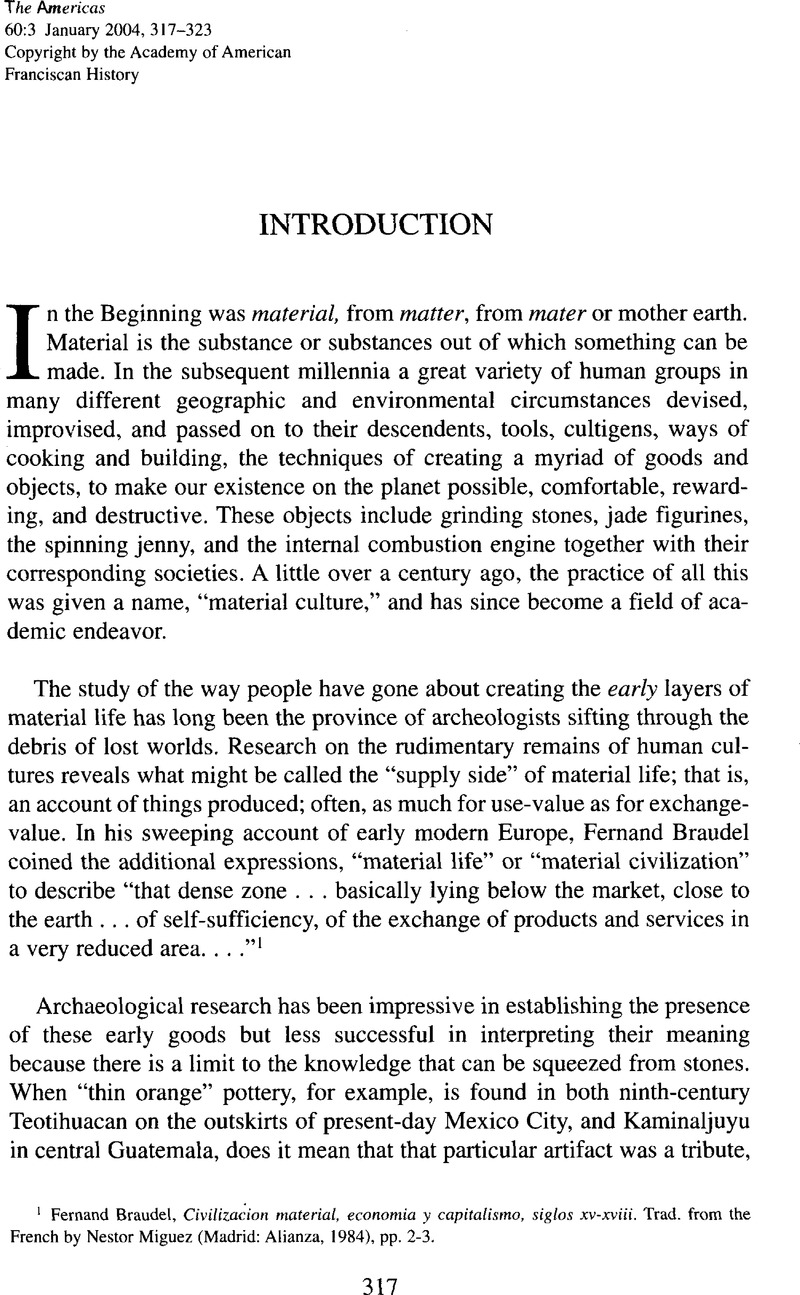No CrossRef data available.
Published online by Cambridge University Press: 11 December 2015

1 Braudel, Fernand, Civilizacion material, economia y capitalismo, siglos xv–xviii. Trad, from the French by Miguez, Nestor (Madrid: Alianza, 1984), pp. 2–3.Google Scholar
2 Although the archaeological work in Latin America, particularly in Mexico and the Andean region, has been outstanding, only a few people have taken up the more recent history of material culture. See, to chose a few examples, the contributors to Fernandez, Rafael Diego, ed., Herencia Espanola en la cultura material de las regiones de Mexico (Zamora, Michoacan: El Colegio de Mexico, 1993)Google Scholar; Aizpuru's, Pilar Gonzalbo edited volumes, Historia de la vida cotidiana (Mexico City: El Colegio de Mexico, 2004)Google Scholar; or the various works on food such as de Mancera, Sonia Concuera, Entre Gula y templanza (Mexico City: Fondo de Cultura Economica, 1999),Google Scholar or the multi-volume, lavishly illustrated, La cocina mexicana a traves de los siglos (Mexico City: Clio 1996). Furthermore, only a handful of researchers outside of Latin America have explicitly taken up the history of consumption or of material culture for that region (although there are many bits and pieces that might be used in writing on that subject). An early classic is Foster, George, Culture and Conquest: America's Spanish Heritage (New York: Wenner Gren Foundation for Anthropology, 1969)Google Scholar; Mintz, Sidney, Sweetness and Power: The Place of Sugar in Modem History (New York: Viking Penguin, 1991)Google Scholar; Van Young, Eric, “Material Life,” in Huberman, Louisa Shell and Socolow, Susan, eds., The Countryside in Latin American History (Albuquerque: Univ. of New Mexico Press, 1996) pp. 49–74 Google Scholar; the chapter on material culture in Angel, Amanda, “Spanish Women in the New World: The Transmission of a Model Polity in New Spain, 1521–1570” (Doctoral dissertation in History, University of California, Davis, 1997)Google Scholar; the contributors’ and his own contributions in Orlove, Benjamin, ed., The Allure of the Foreign: Imported Goods in Postcolonial Latin America (Ann Arbor: Univ. of Michigan Press, 1997)CrossRefGoogle Scholar; Bauer, Arnold J., Goods, Power History: Latin America's Material Culture (Cambridge: Univ. of Cambridge Press, 2001)Google Scholar [Translated as, Somos lo que compramos] (Mexico City: Santillana/Taurus, 2002); Sheller, Mimi, Consuming the Caribbean (London: Routledge, 2003)Google Scholar; and any number of works by Nestor Garcia Canclini. See below, note 6.
3 Morris, Craig, “Wealth of a Native American State,” in Henderson, J. and Netherly, Patricia, eds., Configurations of Power: Holistic Anthropology in Theory and Practice (Ithaca, NY: Cornell Univ. Press, 1993, p. 37–8,Google Scholar 45; D'Altroy, Terranee and Earle, Timothy K., “Staple Finance, Wealth Finance and Storage in the Inka Political Economy, in LeVine, Terry Y., ed., Inka Storage Systems (Norman: Univ. of Oklahoma Press, 1992, pp. 41–72.Google Scholar
4 McKendrick, Neil, Brewer, John, Plumb, J.H., The Birth of a Consumer Society. The Commercialization of Eighteenth-Century England (Bloomington: Univ. of Indiana Press, 1982)Google Scholar; Brewer, John and Porter, Roy, eds., Consumption and World of Goods (London: Routledge, 1993).Google Scholar
5 Leaving aside Veblen, Thorstein, the grandfather of consumer studies, The Theory of the Leisure Class (London: George Allen and Unwin, 1925),Google Scholar the “conditioning of needs” began with the appearance of such landmark books as Packard, Vance, The Hidden Persuaders (New York: Pocket Books, 1957)Google Scholar; Galbraith, J.K., The Affluent Society (London: Hamish Hamilton, 1958),Google Scholar see, Baudrillard, Jean, “Consumer Society,” in Glickman, Lawrence B., ed., Consumer Society in American History: A Reader (Ithaca: Cornell Univ. Press, 1999), pp. 33–56.Google Scholar Since then, and particularly in the last decade, an avalanche of research on consumption on the United States and Europe has appeared. An excellent guide to this literature is in the annotated bibliography by Lawrence B. Glickman in this same volume, pp. 399–414.
6 Tironi, Eugenio, La irrupcion de las masas y el malestar de las elites (Santiago, Chile: Grijalbo, 1999).Google Scholar For fundamental works on the sociology of consumption, see the many works by Canclini, Nestor Garcia, particularly, Consumidores y ciudadanos (Mexico City: Grijalbo, 1995).Google Scholar
7 The New Yorker Magazine, April 26, 1999.
8 Orlove, Benjamin, The Allure of the Foreign, p. 116.Google Scholar
9 Douglas, Mary and Isherwood, Baron, The World of Goods (New York: Basic Books, 1979), pp. 60–64.Google Scholar
To send this article to your Kindle, first ensure no-reply@cambridge.org is added to your Approved Personal Document E-mail List under your Personal Document Settings on the Manage Your Content and Devices page of your Amazon account. Then enter the ‘name’ part of your Kindle email address below. Find out more about sending to your Kindle. Find out more about saving to your Kindle.
Note you can select to save to either the @free.kindle.com or @kindle.com variations. ‘@free.kindle.com’ emails are free but can only be saved to your device when it is connected to wi-fi. ‘@kindle.com’ emails can be delivered even when you are not connected to wi-fi, but note that service fees apply.
Find out more about the Kindle Personal Document Service.
To save this article to your Dropbox account, please select one or more formats and confirm that you agree to abide by our usage policies. If this is the first time you used this feature, you will be asked to authorise Cambridge Core to connect with your Dropbox account. Find out more about saving content to Dropbox.
To save this article to your Google Drive account, please select one or more formats and confirm that you agree to abide by our usage policies. If this is the first time you used this feature, you will be asked to authorise Cambridge Core to connect with your Google Drive account. Find out more about saving content to Google Drive.